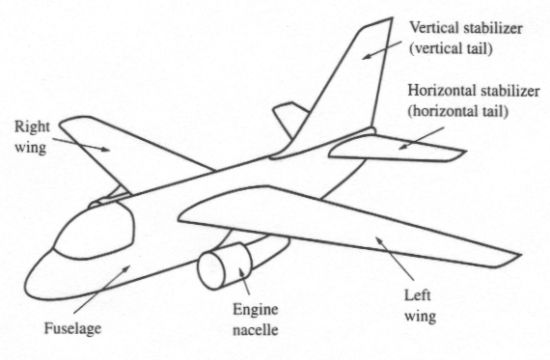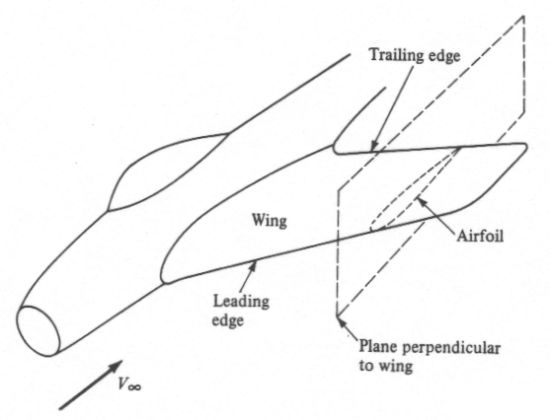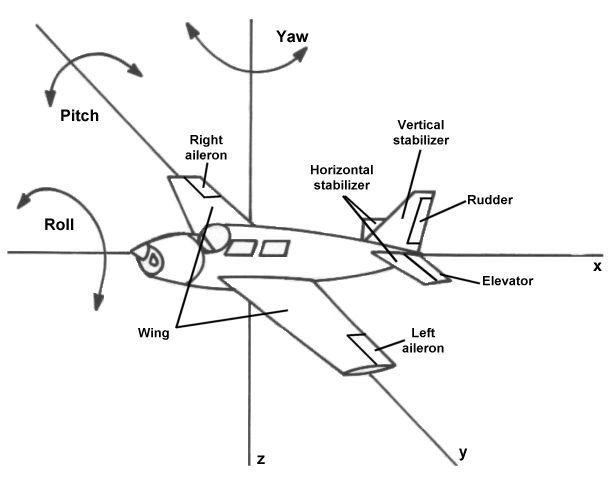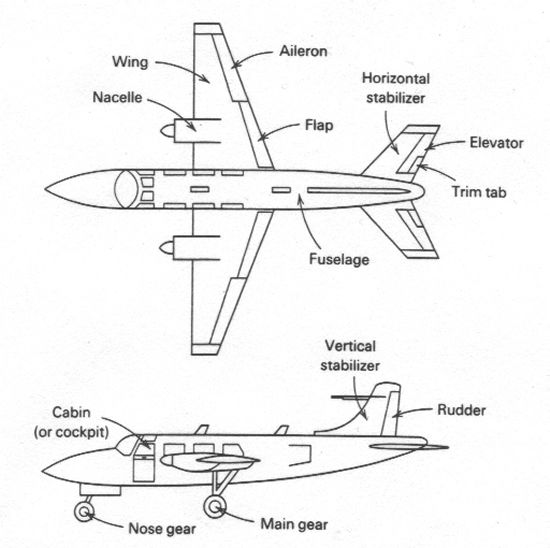| المجموعات الإجتماعية |
| البحث |
| مشاركات اليوم |
 |
| دروس تقنية وصيانة الطائرات يقديم شروح لمنظومات الطائرة تعرض على شكل دروس بطريقة اكاديمية مبسطة |
| إضافة رد |
|
|
أدوات الموضوع |
 |
| دروس تقنية وصيانة الطائرات يقديم شروح لمنظومات الطائرة تعرض على شكل دروس بطريقة اكاديمية مبسطة |
| إضافة رد |
|
|
أدوات الموضوع |
| مشاركة [ 1 ] | ||||
|
||||
|
|
Basic Components  Basic components of an aircraft fuselage The fuselage is that portion of the aircraft that usually contains the crew and payload, either passengers, cargo, or weapons. Most fuselages are long, cylindrical tubes or sometimes rectangular box shapes. All of the other major components of the aircraft are attached to the fuselage. Empennage is another term sometimes used to refer to the aft portion of the fuselage plus the horizontal and vertical tails. wing The wing is the most important part of an aircraft since it produces the lift that allows a plane to fly. The wing is made up of two halves, left and right, when viewed from behind. These halves are connected to each other by means of the fuselage. A wing produces lift because of its special shape, a shape called an airfoil. If we were to cut through a wing and look at its cross-section, as illustrated below, we would see that a traditional airfoil has a rounded leading edge and a sharp trailing edge.  Definition of an airfoil engine The other key component that makes an airplane go is its engine, or engines. Aircraft use several different kinds of engines, but they can all be classified in two major categories. Early aircraft from the Wright Flyer until World War II used propeller-driven piston engines, and these are still common today on light general aviation planes. But most modern aircraft now use some form of a jet engine. Many aircraft house the engine(s) within the fuselage itself. Most larger planes, however, have their engines mounted in separate pods hanging below the wing or sometimes attached to the fuselage. These pods are called nacelles. horizontal stabilizer If an aircraft consists of only a wing or a wing and fuselage, it is inherently unstable. Stability is defined as the tendency of an aircraft to return to its initial state following a disturbance from that state. The horizontal stabilizer, also known as the horizontal tail, performs this function when an aircraft is disturbed in pitch. In other words, if some disturbance forces the nose up or down, the horizontal stabilizer produces a counteracting force to push the nose in the opposite direction and restore equilibrium. When in equilibirum, we say that an aircraft is in its trim condition. The horizontal tail is essentially a miniature wing since it is also made up of an airfoil cross-section. The tail produces a force similar to lift that balances out the lift of the wing to keep the plane in equilibrium. To do so, the tail usually needs to produce a force pointed downward, a quantity called downforce. vertical stabilizer The vertical stabilizer, or vertical tail, functions in the same way as the horizintal tail, except that it provides stability for a disturbance in yaw. Yaw is the side-to-side motion of the nose, so if a disturbance causes the nose to deflect to one side, the vertical tail produces a counteracting force that pushes the nose in the opposite direction to restore equilibrium. The vertical tail is also made of an airfoil cross-section and produces forces just like a wing or horizontal tail. The difference is that a wing or horizontal tail produces lift or downforce, forces that are pointed up or down from the aircraft. Meanwhile the vertical tail produces a force pointed to one side of the aircraft. This force is called side-force. Basic Control Surfaces In addition to the wing and tail surfaces, aircraft need some additional components that give the pilot the ability to control the direction of the plane. We call these items control surfaces.  Aircraft control surfaces and axes of motion elevator The elevator is located on the horizontal stabilizer. It can be deflected up or down to produce a change in the downforce produced by the horizontal tail. The angle of deflection is considered positive when the trailing edge of the elevator is deflected upward. Such a deflection increases the downforce produced by the horizontal tail causing the nose to pitch upward. rudder The rudder is located on the vertical stabilizer. It can be deflected to either side to produce a change in the side-force produced by the vertical tail. The angle of deflection is usually considered positive when the trailing edge of the rudder is deflected towards the right wing. Such a deflection creates a side-force to the left which causes the nose to yaw to the right. aileron Ailerons are located on the tips of each wing. They are deflected in opposite directions (one goes trailing edge up, the other trailing edge down) to produce a change in the lift produced by each wing. On the wing with the aileron deflected downward, the lift increases whereas the lift decreases on the other wing whose aileron is deflected upward. The wing with more lift rolls upward causing the aircraft to go into a bank. The angle of deflection is usually considered positive when the aileron on the left wing deflects downward and that on the right wing deflects upward. The greater lift generated on the left wing causes the aircraft to roll to the right. The effects of these control surfaces and the conventions for positive deflection angles are summarized in the following diagram.  Aircraft control surfaces and positive deflection angles Additional Components We've already seen the major parts of a typical plane, but a few important items were left out for simplicity. Let's go back and discuss a few of these items.  Components of an aircraft flap Flaps are usually located along the trailing edge of both the left and right wing, typically inboard of the ailerons and close to the fuselage. Flaps are similar to ailerons in that they affect the amount of lift created by the wings. However, flaps only deflect downward to increase the lift produced by both wings simultaneously. Flaps are most often used during takeoff and landing to increase the lift the wings generate at a given speed. This effect allows a plane to takeoff or land at a slower speed than would be possible without the flaps. In addition to flaps on the trailing edge of a wing, a second major category is flaps on the leading edge. These leading-edge flaps, more often called slats, are also used to increase lift. More information on slats and flaps is available here. cabin & cockpit Sometimes these two terms are used synonymously, but most of the time the term cockpit is applied to a compartment at the front of the fuselage where the pilots and flight crew sit. This compartment contains the control yolks (or sticks) and equipment the crew use to send commands to the control surfaces and engines as well as to monitor the operation of the vehicle. Meanwhile, a cabin is typically a compartment within the fuselage where passengers are seated. nose & main gear The landing gear is used during takeoff, landing, and to taxi on the ground. Most planes today use what is called a tricycle landing gear arrangement. This system has two large main gear units located near the middle of the plane and a single smaller nose gear unit near the nose of the aircraft. trim tab The above diagram illustrates a "trim tab" located on the elevator. These control tabs may be located on other surfaces as well, such as a rudder control tab or a balance tab on the aileron. Nonetheless, the purpose of all these tabs is the same. In the previous section, we discussed that the horizontal stabilizer and elevator are used to provide stability and control in pitch. In order to keep a plane in a steady, level orientation, the elevator usually has to be deflected by some small amount. Since it would be very tiring for a pilot to physically hold the control stick in position to keep the elevator at that deflection angle for an entire flight, the elevator is fitted with a small "tab" that creates that elevator deflection automatically. The trim tab can be thought of almost as a "mini-elevator." By deflecting the tab up or down, it increases or decreases the downforce created by the elevator and forces the elevator to a certain position. The pilot can set the deflection of the trim tab which will cause the elevator to remain at the deflection required to remain trimmed. المصدر المعهد الذي درست بة
|
|||
|
|

|
| مشاركة [ 2 ] | |||
|
|||
|
Love & Forgetful
    |
ألف شكر لك اخوي وانشاء الله بتفيد كل الدارسين بمجال الطيران
|
||
|
|

|
| مشاركة [ 3 ] | ||||
|
||||
|
|
شكراً لك كابتن طارق 5/5 مجهود متميز |
|||
|
|

|
| مشاركة [ 4 ] | ||||
|
||||
|
|
سلمت يداك كابتن طارق
جهود تستحق الشكر |
|||
|
|

|
| مشاركة [ 5 ] | ||||
|
||||
|
|
ألف شكر لك اخوي وانشاء الله بتفيد كل الدارسين بمجال الطيران
[quote=عماد سعيد;526581] سلمت يداك كابتن طارق جهود تستحق الشكر شكراً أخواني علي المرور |
|||
|
|

|
| مشاركة [ 6 ] | ||||
|
||||
|
|
[quote=mechanic;526364]
شكراً لك كابتن طارق 5/5 مجهود متميز أخي العزيز mechanic يعطيك ألف عافية وشكراً علي مرورك |
|||
|
|

|
| مشاركة [ 7 ] | ||||
|
||||
|
|
يعطيك الف عافية
|
|||
|
|

|
| مشاركة [ 8 ] | ||||
|
||||
|
|
thanks thanks thanks thanks thanks thanks thanks thanks thanks
thanks thanks thanks thanks thanks thanks thanks thanks thanks thanks thanks thanks thanks thanks thanks thanks thanks thanks thanks thanks thanks thanks thanks thanks thanks thanks thanks thanks thanks thanks thanks thanks thanks thanks thanks thanks |
|||
|
|

|
| مشاركة [ 9 ] | ||||
|
||||
|
|
شكرا أخي لهذا العرض المتميز
|
|||
|
|

|
| مشاركة [ 10 ] | ||||
|
||||
|
|
ممتاز 10/10 بس ابغالو ترجمه
|
|||
|
|

|
| مشاركة [ 11 ] | ||||
|
||||
|
|
الشكر لك أخي الكريم .. الموضوع رائع ..
يعطيك العافية |
|||
|
|

|
| إضافة رد |
 دروس تقنية وصيانة الطائرات
دروس تقنية وصيانة الطائرات
|
|
|
|
|
|
 المواضيع المتشابهه
المواضيع المتشابهه
|
||||
| الموضوع | المنتدى | |||
| انواع الضيافه ومهام كل نوع | الضيافة الجوية وسلامة المقصورة - InFlight Service & Cabin Safety | |||
| قوات الدفاع الجوى ورادارات الهوائيات المصفوفة في الحرب الحديثة | القسم العام | |||
| ماهو الفرق بين مهام العمليات الجوية ومهام المرحل الجوي | العمليات الأرضية - الترحيل الجوي | |||
| الفرق بين مهام المرحل الجوي ومهام العمليات الجوية | العمليات الأرضية - الترحيل الجوي | |||